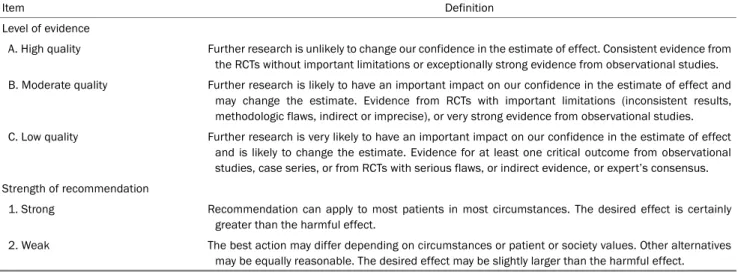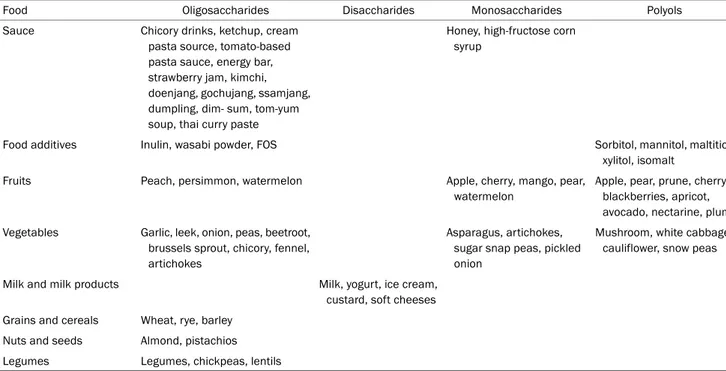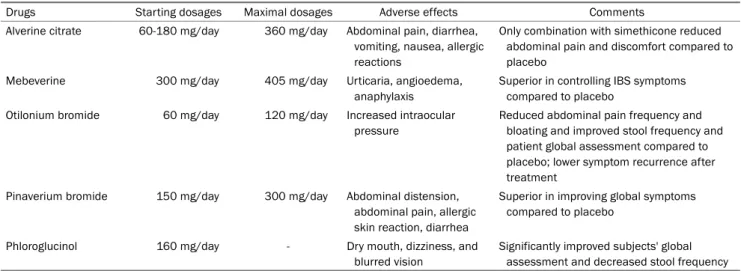BRIEF SUMMARY OF PRACTICE GUIDELINE
2017 과민성장증후군의 임상진료지침 개정안 소개
정혜경
이화여자대학교 의과대학 내과학교실
Review of the Clinical Practice Guidelines for Irritable Bowel Syndrome in Korea, 2017 Revised Edition
Hye-Kyung Jung
Department of Internal Medicine, College of Medicine, Ewha Womans University, Seoul, Korea
This guidance is an updated version of the irritable bowel syndrome (IBS) guidelines based on evidence-based medicine. IBS is a common chronic gastrointestinal syndrome that occurs in approximately 10% of the population and causes chronic abdominal pain as well as bowel habit changes, such as stool frequency or consistency. The final diagnosis of IBS is based on the exclusion of organic diseases that would explain the symptoms and the absence of endoscopic abnormalities. IBS can reduce the quality of life and cause a major disease burden, such as repeated examinations and continuous drug use, by mistaking organic diseases including malignancy. The major changes are as follows: 1) when to perform a colonoscopy under the impression of IBS; 2) effect of a low-fer- mentable oligosaccharides, disaccharides, monosaccharides, and polyol diet; 3) impact of probiotics in IBS; and 4) role of antibiotics in IBS. The Korean Society of Neurogastroenterology and Motility recently updated these guidelines to support physicians for qualified medical services and reduce the socioeconomic burden of IBS. (Korean J Gastroenterol 2018;72:252-257)
Key Words: Evidence-based practice; Irritable bowel syndrome; Practice guideline
Received October 1, 2018. Revised October 23, 2018. Accepted November 3, 2018.
CC This is an open access article distributed under the terms of the Creative Commons Attribution Non-Commercial License (http://creativecommons.org/licenses/
by-nc/4.0) which permits unrestricted non-commercial use, distribution, and reproduction in any medium, provided the original work is properly cited.
Copyright © 2018. Korean Society of Gastroenterology.
교신저자: 정혜경, 07985, 서울시 양천구 안양천로 1071, 이화여자대학교 의과대학 내과학교실
Correspondence to: Hye-Kyung Jung, Department of Internal Medicine, College of Medicine, Ewha Womans University, 1071 Anyangcheon-ro, Yangcheon-gu, Seoul 07985, Korea. Tel: +82-2-2650-2874, Fax: +82-2-2655-2874, E-mail: junghk@ewha.ac.kr, ORCID: https://orcid.org/0000-0002-6653-5214
Financial support: None. Conflict of Interest: None.
서 론
과민성장증후군이란 반복적으로 복통과 함께 복부 불편감, 배변 습관의 변화, 복부 팽만감 등 다양한 하부위장관 증상이 나타나는 증후군으로 만성적으로 호전과 악화를 반복한다.1,2 과민성장증후군의 최종 진단은 증상을 설명할만한 다른 기질 적인 질환이 없다는 것을 검사를 통하여 확인한 다음에 내린 다. Rome IV 기준에 의하면 과민성장증후군은 평균 주 1일 이상의 복통이 6개월 전에 시작되고 지난 3개월 동안 반복되 면서 두 가지 이상의 동반 증상(배변과 연관된 복통, 배변 횟 수의 증가 혹은 감소, 대변이 물러지거나 단단해지는 배변 굳 기의 변화)이 함께 있을 때로 정의한다.3로마기준은 적용 기
준이 엄격하여 주로 임상 연구 등을 목적으로 할 때 많이 사용 되며, 실제 임상에서는 그 빈도나 강도보다 더 융통성이 있는 진단 기준으로 진단한다.
과민성장증후군은 지역사회 인구 기반 연구에서 10% 가량 으로 흔한 기능성 위장관 질환이고, 아시아 국가에서 증가 추 세에 있으며,4-7 이로 인한 사회경제적 비용은 상당할 것으로 추정된다.8 과민성장증후군은 로마기준에 합당한 증상이 있으 면서 이와 유사한 증상을 유발하는 기질 질환을 제외하여 진 단하기 때문에 진단을 위한 비용이 많이 들 뿐 아니라, 질환 자체가 만성적으로 호전과 악화를 반복하여 치료를 위한 의료 이용 비용도 높다.
대한소화기기능성질환·운동학회는 2005년에 “과민성장증
Table 1. Level of Evidence and Grade of Recommendation
Item Definition
Level of evidence
A. High quality Further research is unlikely to change our confidence in the estimate of effect. Consistent evidence from the RCTs without important limitations or exceptionally strong evidence from observational studies.
B. Moderate quality Further research is likely to have an important impact on our confidence in the estimate of effect and may change the estimate. Evidence from RCTs with important limitations (inconsistent results, methodologic flaws, indirect or imprecise), or very strong evidence from observational studies.
C. Low quality Further research is very likely to have an important impact on our confidence in the estimate of effect and is likely to change the estimate. Evidence for at least one critical outcome from observational studies, case series, or from RCTs with serious flaws, or indirect evidence, or expert’s consensus.
Strength of recommendation
1. Strong Recommendation can apply to most patients in most circumstances. The desired effect is certainly greater than the harmful effect.
2. Weak The best action may differ depending on circumstances or patient or society values. Other alternatives may be equally reasonable. The desired effect may be slightly larger than the harmful effect.
RCT, randomized controlled trial.
후군의 진단 및 치료 가이드라인”을 발표하였고 2010년과 2011년에 걸쳐 그 개정안을 발표하였다.9-12이번에 개정된 진 료 지침은 2011년 진료 지침에서 근거가 강화되거나 새로운 근거가 창출된 주제에 관하여 체계적 문헌고찰을 통하여 그 근거와 권고 등급을 결정하였다(Table 1). 본고에서는 새로이 개정되거나 변화된 네 개의 주제, 즉 과민성장증후군이 의심 되는 환자에서 언제 대장내시경을 시행할 것인지, 저포드맵 식이의 유용성, 과민성장증후군 치료에서 생균제와 항생제의 역할을 중심으로 고찰하여 보고자 한다. 이 이외의 내용은 영 문으로 출간된 ‘Clinical Practice Guidelines for Irritable Bowel Syndrome in Korea, 2017 Revised Edition’에 자세 히 소개되어 있으니 참고하기 바란다.13
본 론
1. 대장내시경
1) 과민성장증후군이 의심되는 환자에서 경고 증상, 측 항 문 출혈, 원인 불명의 체중 감소, 50세 이상에서의 배변 습관 변화가 있거나 소화기암의 가족력이 있을 때 대장 내시경을 고려할 수 있다.
• 권고수준: 약함
• 증거수준: 중등도
• 전문가 의견: 전적으로 동의함(37.5%), 대체로 동의함 (47.5%), 일부 동의함(10.0%), 대체로 동의하지 않음 (2.5%), 전적으로 동의하지 않음(2.5%), 모르겠음(0%)
과민성장증후군은 로마기준에 따라 특징적인 증상이 있을
경우에 진단할 수 있다.3증상만으로 과민성장증후군과 유사 한 증상을 유발하는 기질적 질환을 감별하기 어렵다. 대장내 시경은 과민성장증후군 환자를 진단하는 효용은 낮으나 경고 징후가 있는 경우 대장내시경을 시행하면 염증성 장질환, 대 장암, 현미경적 장염 등을 감별하는데 도움을 줄 수 있다. 따 라서 혈변, 빈혈, 원인 불명의 체중 감소, 최근 배변 습관의 변화 등 경고 증상이 있으면 과민성장증후군을 생각하기에 앞 서 다른 진단을 고려해야 한다.2,14-16 로마기준과 같은 엄격한 과민성장증후군의 증상 진단기준은 경고 징후가 없는 경우에 과민성장증후군을 진단하는데 높은 예측도를 지닌다.14 2. 식이
1) fermentable oligosaccharides, disaccharides, mono- saccharides, and polyols (FODMAP) 제한 식이는 과민 성장증후군 증상 조절에 효과적이다.
• 권고수준: 약함
• 증거수준: 낮음
• 전문가 의견: 전적으로 동의함(5.0%), 대체로 동의함 (67.5%), 일부 동의함(25.0%), 대체로 동의하지 않음 (2.5%), 전적으로 동의하지 않음(0%), 모르겠음(0%)
FODMAP은 장내 세균에 의하여 발효될 수 있는 저분자 탄수화물 등을 통칭하며, 장관내의 삼투압을 증가시켜 배변의 양상을 변화시키거나 가스를 생성하여 과민성장증후군 환자 의 증상의 악화를 초래할 수 있다.17 최근 연구에서 FODMAP 이 많이 함유된 음식을 제한하는 식이가 증상을 완화시키는데 도움이 되었다. 흔하게 접하는 고농도의 FODMAP 식이를
Table 2. Common Food Sources of High FODMAPs
Food Oligosaccharides Disaccharides Monosaccharides Polyols
Sauce Chicory drinks, ketchup, cream pasta source, tomato-based pasta sauce, energy bar, strawberry jam, kimchi, doenjang, gochujang, ssamjang, dumpling, dim- sum, tom-yum soup, thai curry paste
Honey, high-fructose corn syrup
Food additives Inulin, wasabi powder, FOS Sorbitol, mannitol, maltitiol,
xylitol, isomalt
Fruits Peach, persimmon, watermelon Apple, cherry, mango, pear,
watermelon
Apple, pear, prune, cherry, blackberries, apricot, avocado, nectarine, plum Vegetables Garlic, leek, onion, peas, beetroot,
brussels sprout, chicory, fennel, artichokes
Asparagus, artichokes, sugar snap peas, pickled onion
Mushroom, white cabbage, cauliflower, snow peas
Milk and milk products Milk, yogurt, ice cream,
custard, soft cheeses Grains and cereals Wheat, rye, barley
Nuts and seeds Almond, pistachios Legumes Legumes, chickpeas, lentils
FODMAP, fermentable oligosaccharides, disaccharides, monosaccharides, and polyols; FOS, fructooligosaccharides.
Table 2에 정리하였다.17,18 세 개의 전향적 연구의 결과 FODMAP 제한 식이는 복통 및 복부 팽만감(bloating)을 호 전시켰다.19-21 FODMAP 제한 식이의 부작용은 보고되지 않 았으나, 이 연구들의 시행 기간이 4주 이하로 상대적으로 짧 아, 장기간의 FODMAP 제한 식이가 어떠한 영향을 끼칠지에 대한 후속 연구가 필요하다.
3. 신체활동
1) 신체활동은 과민성장증후군 환자의 증상 호전에 도움을 줄 수 있다.
• 권고수준: 약함
• 증거수준: 낮음
4. 부피형성 완하제
1) 부피형성 완하제는 과민성장증후군 환자의 전반적인 증 상을 호전시킬 수 있다.
• 권고수준: 약함
• 증거수준: 중등도
5. 삼투성 완하제
1) 삼투성 완하제는 변비 우세형 과민성장증후군에서 배변 빈도를 증가시켜 증상을 완화시킬 수 있다.
• 권고수준: 약함
• 증거수준: 중등도
6. 진경제(Table 3)
1) 진경제는 과민성장증후군의 복부 불편감을 완화시키는 데 효과적이다.
• 권고수준: 강함
• 증거수준: 중등도
7. 지사제
1) 로페라마이드는 설사 우세형 과민성장증후군에서 대변 성상을 정상화시키고 배변 빈도를 감소시킨다.
• 권고수준: 강함
• 증거수준: 낮음
Table 3. Summary of Antispasmodics for the Treatment of Irritable Bowel Syndrome
Drugs Starting dosages Maximal dosages Adverse effects Comments
Alverine citrate 60-180 mg/day 360 mg/day Abdominal pain, diarrhea, vomiting, nausea, allergic reactions
Only combination with simethicone reduced abdominal pain and discomfort compared to placebo
Mebeverine 300 mg/day 405 mg/day Urticaria, angioedema,
anaphylaxis
Superior in controlling IBS symptoms compared to placebo
Otilonium bromide 60 mg/day 120 mg/day Increased intraocular pressure
Reduced abdominal pain frequency and bloating and improved stool frequency and patient global assessment compared to placebo; lower symptom recurrence after treatment
Pinaverium bromide 150 mg/day 300 mg/day Abdominal distension, abdominal pain, allergic skin reaction, diarrhea
Superior in improving global symptoms compared to placebo
Phloroglucinol 160 mg/day - Dry mouth, dizziness, and
blurred vision
Significantly improved subjects' global assessment and decreased stool frequency IBS, irritable bowel syndrome.
Table 4. Summary of Antidepressants for the Treatment of Irritable Bowel Syndrome Psycho-trophics Drugs Starting
dosages
Maximal
dosages Adverse effects Comments
TCAs Amitriptyline 10-25 mg/day 30 mg/day Dry mouth, constipation, difficulty sleeping, difficulty urinating, sexual difficulties, headache, nausea, dizziness and/or drowsiness
Begin with low dose (at bedtime) and titrate by response Imipramine 25 mg/day 50 mg/day
Desipramine 50 mg/day 150 mg/day
Trimipramine 50 mg/day -
SSRIs Paroxetine 10-20 mg/day 50 mg/day Agitation, dizziness, nausea, headache, vivid dreams, sleep disturbances, sexual difficulties, and/or diarrhea
Begin with low dose and titrate by response
Citalopram 20 mg/day 40 mg/day
Fluoxetine 20 mg/day -
TCA, tricyclic antidepressant; SSRI, selective serotonin reuptake inhibitor.
8. 세로토닌 3형 수용체 길항제(5-HT3 receptor antagonist)
1) 세로토닌 3형 수용체 길항제인 ramosetron은 설사 우세 형 과민성장증후군 환자들의 대변의 굳기, 복통, 복부 팽 만감 및 건강과 관련된 삶의 질을 향상시킨다.
• 권고수준: 약함
• 증거수준: 높음
9. 세로토닌 4형 수용체 작용제(5-HT4 receptor agonist)
1) 다른 하제에 반응이 없는 변비 우세형 과민성장증후군 환자에게 prucalopride는 관련 증상 개선과 삶의 질 향 상에 도움이 될 수 있다.
• 권고수준: 약함
• 증거수준: 중등도
10. 항생제
1) 리팍시민은 설사 우세형 과민성장증후군의 전신 증상을 완화시키는데 효과적일 수 있다.
• 권고수준: 약함
• 증거수준: 중등도
• 전문가 의견: 전적으로 동의함(7.5%), 대체로 동의함 (42.5%), 일부 동의함(45.0%), 대체로 동의하지 않음 (2.5%), 전적으로 동의하지 않음(0%), 모르겠음(2.5%).
리팍시민(rifaximin)은 과민성장증후군에서 동반할 수 있 는 소장 세균 과증식에 항생제를 투여하면 그 증상이 호전된 다는 보고가 있다.22최근에 발표된 몇몇의 무작위 대조시험에 서 리팍시민은 설사 우세형 과민성장증후군에서 복통, 복부 팽만감, 대변 성상의 정상화에 효과가 있으며 증상이 재발하 는 경우에도 반복적인 치료가 효과적이다.23-27 소화관에서 흡 수가 잘 되지 않아 부작용이 거의 없다. 그러나 항생제 내성 위험성을 고려하여, 다른 약제로도 호전되지 않은 일부 환자 들에 한하여 제한적으로 투약하는 것을 권장한다.
11. 생균제
1) 생균제는 과민성장증후군 환자의 전반적인 증세 및 가스 관련 증상 등의 호전을 위하여 보조적으로 투약해 볼 수 있다.
• 권고수준: 약함
• 증거수준: 낮음
• 전문가 의견: 전적으로 동의함(7.5%), 대체로 동의함 (55.0%), 일부 동의함(27.5%), 대체로 동의하지 않음 (7.5%), 전적으로 동의하지 않음(0%), 모르겠음(2.5%)
과민성장증후군 환자에게 생균제를 투약하여 장내 미생물 무리의 조성을 바꾸어줌으로써 증상을 호전시켰다는 임상 연 구가 보고되어 왔다. 2014년 메타분석에 의하면 위약대비 생 균제의 투약은 증상을 비교위험도 0.79 (95% CI 0.70-0.89)로 유의하게 증상을 개선시킬 수 있었고, 7명의 투약으로 한 명의 호전을 기대할 수 있는 수준이었다.28 과민성장증후군의 전반적 증상의 개선, 복통의 호전, 가스 관련 증상의 호전 등 모든 영역에서 위약대비 효과가 있었다. 국내에서도 각종
Lactobacillus
및Bifidobacterium
의 혼합제제,Bacillus subtillis
,Streptococcus faecium
,Saccharomyces bou- lardii
등을 사용한 임상 연구들이 있었다.29-32 하지만 이제까지 의 연구 결과로는 과민성장증후군 환자에게 특정 균주나 용량 을 추천할 수는 없고, 다만 그 효과를 판정하기 위해서는 4주 이상 지속적으로 투약하여 볼 것을 권고하고 있다.12. 항우울제(Table 4)
1) 삼환계 항우울제(tricyclic antidepressants)는 과민성장 증후군 환자의 복통과 전반적인 증상개선을 위하여 사용 해 볼 수 있다.
• 권고수준: 약함
• 증거수준: 높음
13. 기타 치료들: chloride channel activators 및 정신건강 의학과적 치료
1) 선택적 세로토닌 재흡수억제제는 과민성장증후군 환자 의 안녕감을 향상시키기 위하여 사용해 볼 수 있다.
• 권고수준: 약함
• 증거수준: 중등도
결 론
2017년 개발된 과민성장증후군 영문 임상 진료 지침은 2011 년에 발표된 진료 지침을 근간으로 근거 중심 의학에 기반하 여 개정하였다. 과민성장증후군에서 대장내시경의 역할과 최 근 활발히 연구가 진행된 FODMAP 식이, 항생제 및 생균제 에 대하여 체계적 문헌고찰을 실시하였고, 델파이 방법을 통 하여 전문가 합의를 도출하여 새로운 권고문을 개발하였다.
과민성장증후군의 임상 접근을 쉽게 하기 위하여 과민성장증 후군 진료 알고리즘 및 치료 약제의 구체적인 방법을 표로 요약하였다. 본 진료 지침은 진료를 담당하는 의사와 환자가 일선에서 사용하여 최선의 치료를 제공하고 만족할 만한 치유 경험을 통하여 궁극적으로 삶의 질을 향상시키고 의료 비용을 줄이는 것을 목표로 한다. 뿐만 아니라 내과 및 가정의학과를 비롯한 다양한 임상과의 수련의 및 의과대학 학생, 간호대 학 생 등의 교육을 위하여 적용될 수 있다.
REFERENCES
1. Spiller R, Aziz Q, Creed F, et al. Guidelines on the irritable bowel syndrome: mechanisms and practical management. Gut 2007;
56:1770-1798.
2. Hookway C, Buckner S, Crosland P, Longson D. Irritable bowel syndrome in adults in primary care: summary of updated NICE guidance. BMJ 2015;350:h701.
3. Mearin F, Lacy BE. Diagnostic criteria in IBS: useful or not?
Neurogastroenterol Motil 2012;24:791-801.
4. Lee SY, Lee KJ, Kim SJ, Cho SW. Prevalence and risk factors for overlaps between gastroesophageal reflux disease, dyspepsia, and irritable bowel syndrome: a population-based study. Digestion 2009;79:196-201.
5. Lee YY, Waid A, Tan HJ, Chua AS, Whitehead WE. Rome III survey of irritable bowel syndrome among ethnic Malays. World J Gastroenterol 2012;18:6475-6480.
6. Siah KT, Wong RK, Chan YH, Ho KY, Gwee KA. Prevalence of irrita- ble bowel syndrome in Singapore and its association with dietary, lifestyle, and environmental factors. J Neurogastroenterol Motil 2016;22:670-676.
7. Miwa H. Prevalence of irritable bowel syndrome in Japan: inter- net survey using Rome III criteria. Patient Prefer Adherence 2008;2:143-147.
8. Buono JL, Mathur K, Averitt AJ, Andrae DA. Economic burden of inadequate symptom control among US commercially insured patients with irritable bowel syndrome with diarrhea. J Med Econ 2017;20:353-362.
9. Lee OY, Yoon CO. Review : evidence based guideline for diagnosis and treatment : diagnostic guideline for irritable bowel syndrome.
Kor J Neurogastroenterol Motil 2005;11:30-35.
10. Park HJ. Review : evidence based guideline for diagnosis and treatment : therapeutic guideline for irritable bowel syndrome.
Kor J Neurogastroenterol Motil 2005;11:36-43.
11. Park JH, Byeon JS, Shin WG, et al. Diagnosis of irritable bowel syn- drome: a systematic review. Korean J Gastroenterol 2010;55:
308-315.
12. Kwon JG, Park KS, Park JH, et al. Guidelines for the treatment of irritable bowel syndrome. Korean J Gastroenterol 2011;57:82-99.
13. Song KH, Jung HK, Kim HJ, et al. Clinical practice guidelines for irritable bowel syndrome in Korea, 2017 revised edition. J Neurogastroenterol Motil 2018;24:197-215.
14. Hammer J, Eslick GD, Howell SC, Altiparmak E, Talley NJ.
Diagnostic yield of alarm features in irritable bowel syndrome and functional dyspepsia. Gut 2004;53:666-672.
15. Whitehead WE, Palsson OS, Feld AD, et al. Utility of red flag symp- tom exclusions in the diagnosis of irritable bowel syndrome.
Aliment Pharmacol Ther 2006;24:137-146.
16. Black TP, Manolakis CS, Di Palma JA. "Red flag" evaluation yield in irritable bowel syndrome. J Gastrointestin Liver Dis 2012;
21:153-156.
17. Gibson PR, Shepherd SJ. Food choice as a key management strat- egy for functional gastrointestinal symptoms. Am J Gastroenterol 2012;107:657-666; quiz 667.
18. Iacovou M, Tan V, Muir JG, Gibson PR. The low FODMAP diet and its application in East and Southeast Asia. J Neurogastroenterol Motil 2015;21:459-470.
19. Halmos EP, Power VA, Shepherd SJ, Gibson PR, Muir JG. A diet low in FODMAPs reduces symptoms of irritable bowel syndrome.
Gastroenterology 2014;146:67-75.e5.
20. Staudacher HM, Lomer MC, Anderson JL, et al. Fermentable car- bohydrate restriction reduces luminal bifidobacteria and gastro- intestinal symptoms in patients with irritable bowel syndrome. J Nutr 2012;142:1510-1518.
21. Staudacher HM, Whelan K, Irving PM, Lomer MC. Comparison of symptom response following advice for a diet low in fermentable carbohydrates (FODMAPs) versus standard dietary advice in pa- tients with irritable bowel syndrome. J Hum Nutr Diet 2011;
24:487-495.
22. Pimentel M, Chow EJ, Lin HC. Normalization of lactulose breath testing correlates with symptom improvement in irritable bowel syndrome. A double-blind, randomized, placebo-controlled study.
Am J Gastroenterol 2003;98:412-419.
23. Sharara AI, Aoun E, Abdul-Baki H, Mounzer R, Sidani S, Elhajj I.
A randomized double-blind placebo-controlled trial of rifaximin in patients with abdominal bloating and flatulence. Am J Gastroenterol 2006;101:326-333.
24. Pimentel M, Park S, Mirocha J, Kane SV, Kong Y. The effect of a nonabsorbed oral antibiotic (rifaximin) on the symptoms of the irritable bowel syndrome: a randomized trial. Ann Intern Med 2006;145:557-563.
25. Pimentel M, Lembo A, Chey WD, et al. Rifaximin therapy for pa- tients with irritable bowel syndrome without constipation. N Engl J Med 2011;364:22-32.
26. Lembo A, Pimentel M, Rao SS, et al. Repeat treatment with rifax- imin is safe and effective in patients with diarrhea-predominant irritable bowel syndrome. Gastroenterology 2016;151:1113-1121.
27. Chang L, Lembo A, Sultan S. American gastroenterological asso- ciation institute technical review on the pharmacological man- agement of irritable bowel syndrome. Gastroenterology 2014;
147:1149-1172.e2.
28. Ford AC, Quigley EM, Lacy BE, et al. Efficacy of prebiotics, pro- biotics, and synbiotics in irritable bowel syndrome and chronic idiopathic constipation: systematic review and meta-analysis.
Am J Gastroenterol 2014;109:1547-1561; quiz 1546, 1562.
29. Yoon JS, Sohn W, Lee OY, et al. Effect of multispecies probiotics on irritable bowel syndrome: a randomized, double-blind, place- bo-controlled trial. J Gastroenterol Hepatol 2014;29:52-59.
30. Cha BK, Jung SM, Choi CH, et al. The effect of a multispecies pro- biotic mixture on the symptoms and fecal microbiota in diar- rhea-dominant irritable bowel syndrome: a randomized, dou- ble-blind, placebo-controlled trial. J Clin Gastroenterol 2012;
46:220-227.
31. Choi CH, Jo SY, Park HJ, Chang SK, Byeon JS, Myung SJ. A random- ized, double-blind, placebo-controlled multicenter trial of sac- charomyces boulardii in irritable bowel syndrome: effect on qual- ity of life. J Clin Gastroenterol 2011;45:679-683.
32. Sinn DH, Song JH, Kim HJ, et al. Therapeutic effect of Lactobacillus acidophilus-SDC 2012, 2013 in patients with irritable bowel syndrome. Dig Dis Sci 2008;53:2714-2718.


